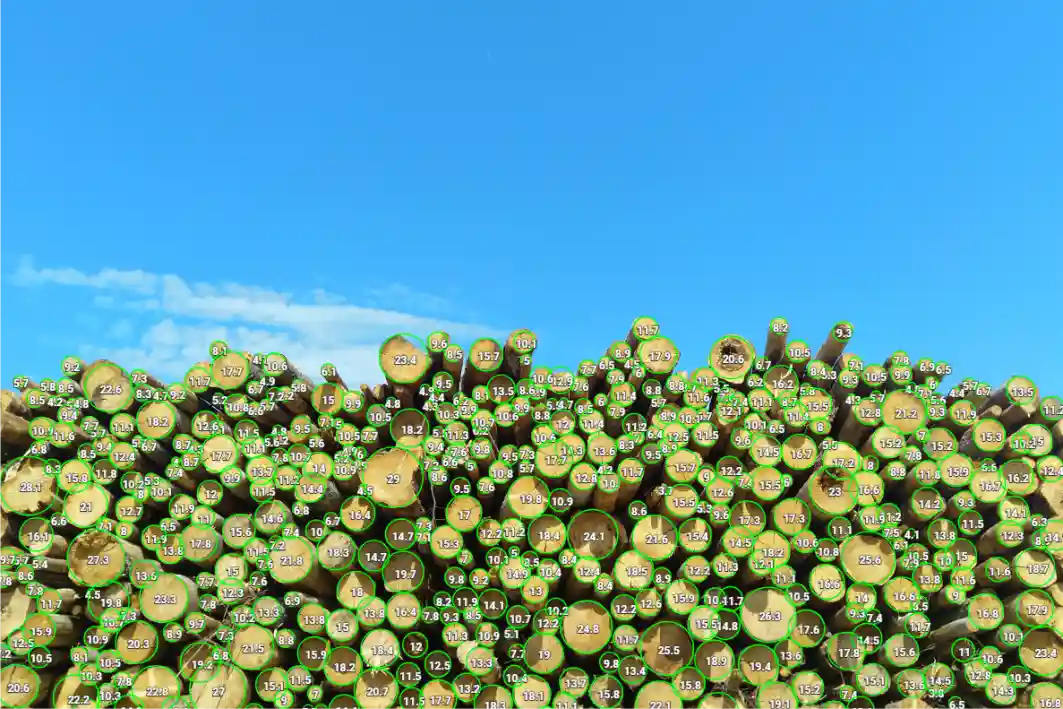When users start testing Timbeter, one of the first questions they might encounter regards the best functionality for measuring logs according to their business need. Timbeter has four different functionalities – diameter, pile, truck and density. Each company can easily find the functionality that meet their requirements.
We will briefly explain each of these functionalities and how they can help you to measure logs for different purposes to increase accuracy, efficiency and profit in your business.
DIAMETER MEASUREMENT
The most commonly used Timbeter functionality for measuring logs is the diameter measurement. This function provides the number of logs in a pile, the average diameter, the individual diameter of each of these logs, as well as the distribution of the diameters in percentage according to the result.
The volume calculation is based on one of the 15 different formulas used worldwide that are present in the solution and can be selected by the user according to regional or industry needs.
This function is especially used by sawmill owners and their staff who need to have greater control of logs going to production to ensure the most optimal input of diameters. The distribution of diameters is also a very important tool in wood trade, since there is always a digital proof together with the measurement made with Timbeter, which can be easily shared externally and controlled.
PILE MEASUREMENT
The second most commonly used Timbeter feature is the pile measurement. With this functionality, the user can measure the total volume of a log pile and add the automatic pile height marking. To measure the cubic volume of a pile of logs with Timbeter, it is necessary to use the results of the density* functionality, which gives the result of the proportion of wood in a pile excluding air and bark.
With this feature, users can check what is the actual amount of wood in a pile, so it can be routed to different processes within a factory. Most companies who are using this feature measure pulpwood as well as fuelwood.
TRUCK MEASUREMENT
In the same way that the pile measurement works, the measurement of truck loads can also be done with Timbeter. This function, as well as the pile measurement, provides the volume of truck loads with the aid of density* measurement in conjunction with the length and width of the loads.
This functionality is of the utmost importance for companies that buy and sell wood, since it is much easier to maintain digital and visual control of the trucks entering the factory gates, as well as gathering information about the license plates and responsible drivers.
Truck load measurement is also very useful for companies who are exporting logs, as it is much easier to understand the exact volume that must be transported to the containers, avoiding unnecessary queuing, waiting and driving.
DENSITY MEASUREMENT
The density measurement was made considering the users’ need to obtain the real volume of log piles. Density measurement has become a key feature for companies that use cubic volume in the measurement of pulpwood as well as fuelwood, which is extremely important in the following stages of production, since this function is decisive when provided if there is an overestimation or underestimation of the amount of wood that is processed, bringing more efficiency to the processes.
In addition, this functionality has been used by companies instead of manual methods, such as square metering and tables that delimit the stacking factor, because they are less precise and generally underestimate the results.
When measuring the density using Timbeter, the result will be decimal (0.0000 model), which should be converted into a percentage when applied to the pile or truck measurement. For example, a resulting density measurement of 0.5643 should be transformed to 56%, which means that in a pile, there is 56% of wood and the remainder is air and bark.
Now that you know the main features of Timbeter, you can check our YouTube tutorials and get in touch with our team on info@timbeter.com to understand how we can bring countless benefits to your business.
